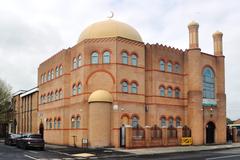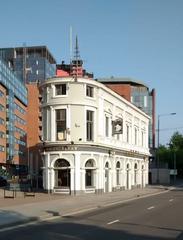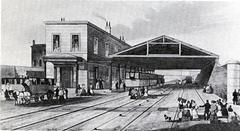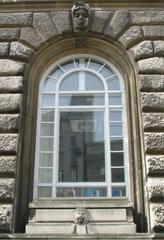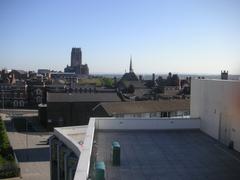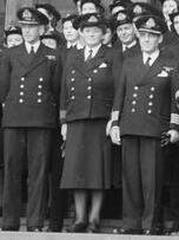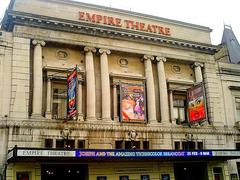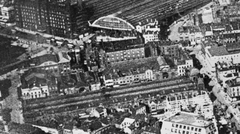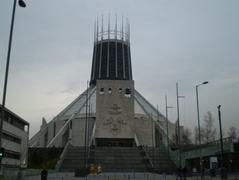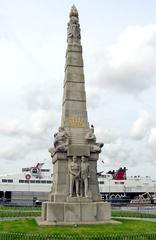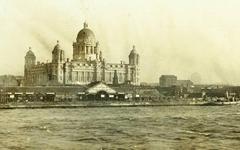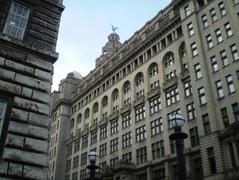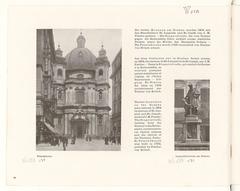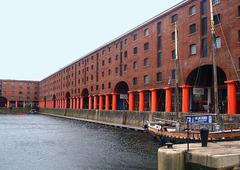Arandora Star Memorial Visiting Hours, Tickets, and Liverpool Historical Sites Guide
Date: 14/06/2025
Introduction
The Arandora Star Memorial at Liverpool’s Pier Head is a moving tribute to one of World War II’s most tragic maritime disasters. On July 2, 1940, the SS Arandora Star, carrying over 1,600 internees—mainly Italian and German civilians—along with British guards and crew, was torpedoed by a German submarine en route from Liverpool to Canada. More than 800 lives were lost, marking a profoundly somber chapter in British and immigrant wartime history (Wikipedia; Blue Star Line).
Situated at Liverpool’s historic Pier Head—a UNESCO World Heritage Site—the memorial is not only a focal point for remembrance but also a symbol of the city’s multicultural legacy and the enduring bonds within its Italian and German communities (LiquiSearch; Ancoats Little Italy). This comprehensive guide offers historical context, detailed visitor information, and recommendations for making the most of your visit to the Arandora Star Memorial and Liverpool’s other nearby historical sites.
Table of Contents
- Historical Background: The Arandora Star Tragedy
- Creation and Symbolism of the Memorial
- Visiting Information
- Educational and Cultural Significance
- Frequently Asked Questions (FAQ)
- Conclusion
- References
Historical Background: The Arandora Star Tragedy
Launched in 1927 as part of the Blue Star Line’s “luxury five,” the SS Arandora Star was initially a glamorous cruise liner, famed for its opulence and distinctive white hull with a scarlet ribbon (Wikipedia; Daily Record). With the outbreak of WWII, the ship was requisitioned, stripped of its luxurious interiors, painted grey, and converted for troop transport (St John Street).
In June 1940, following Italy’s entry into the war, the British government began mass internment of “enemy aliens,” mostly Italian and German civilians residing in the UK (Wales Online). The Arandora Star was tasked with transporting these internees, along with German POWs, to Canada.
On July 2, 1940, about 75 miles west of Bloody Foreland, Ireland, the ship was struck by a torpedo from German U-boat U-47 and sank within 30 minutes. Barbed wire barriers and locked areas hampered evacuation, resulting in the loss of 805 lives, including 470 Italians, 243 Germans, 37 British guards, and 55 crew (Blue Star Line; DFHG). The tragedy led to widespread outrage and a reevaluation of British internment policies (Ancoats Little Italy).
Creation and Symbolism of the Memorial
The Arandora Star tragedy went largely unacknowledged for decades, but sustained efforts by the Italian and German communities led to the establishment of memorials across the UK. In Liverpool, a bronze plaque was first unveiled in 2008 at the Church of Our Lady and St Nicholas and later moved to the Pier Head, in front of the Mersey Docks and Harbour Board building (LiquiSearch; Colonsay History). The memorial’s design—an understated plaque inscribed in English and Italian—invites quiet reflection, facing the River Mersey, the last sight of home for many victims.
Annual remembrance ceremonies, often held around July 2, draw descendants, community members, and visitors, reinforcing the memorial’s role as a living site of memory (Ancoats Little Italy; DFHG).
Visiting Information
Location and Access
- Address: Pier Head, Liverpool Waterfront, L3 1DP, United Kingdom
- Setting: The memorial is located outdoors at Pier Head, a central and iconic part of Liverpool’s UNESCO World Heritage waterfront.
Visiting Hours and Tickets
- Open 24/7: The memorial is accessible year-round, at all hours.
- No Tickets Required: Visiting is free of charge.
Accessibility
- Wheelchair Access: The area features level, paved walkways suitable for wheelchairs and strollers.
- Guide Dogs: Assistance animals are welcome.
- Nearby Facilities: Accessible restrooms are available at the Museum of Liverpool and Mersey Ferries terminal (VisitLiverpool).
Getting There
- By Train: Liverpool Lime Street and James Street stations are within a 15-minute walk.
- By Bus: Multiple city bus routes stop near Pier Head.
- By Car: Nearby car parks include Q-Park Liverpool ONE and Liverpool Waterfront Car Park.
- On Foot: The memorial is adjacent to major landmarks like the Three Graces and the Museum of Liverpool.
Best Times to Visit
- Anniversary Events: The largest gatherings occur on or near July 2, marking the sinking’s anniversary.
- General Visits: For a quieter experience, visit early mornings or weekdays. Spring and summer offer mild weather and vibrant surroundings.
Nearby Amenities and Attractions
- Cafés and Restaurants: Numerous options along the waterfront and at Liverpool ONE.
- Other Attractions: The Merseyside Maritime Museum, Museum of Liverpool, the Beatles Story, Royal Albert Dock, and the Three Graces are all within walking distance (VisitLiverpool).
- Public Restrooms: Available at the Museum of Liverpool and the ferry terminal.
Guided Tours and Commemorative Events
- Guided Walking Tours: Several local heritage tours include the memorial, providing historical context and storytelling.
- Commemorative Events: Annual ceremonies around July 2 attract communities from the UK, Italy, and Germany (MG Foundation). To participate, check with the Liverpool Tourist Information Centre or download the Audiala app for schedules and updates.
Educational and Cultural Significance
The Arandora Star Memorial is a focal point for education on wartime internment, migration, and national identity. It is featured in school projects, documentaries, and local museum exhibits (Liverpool Museums). The story is also explored through oral histories and community research, fostering ongoing dialogue about the impact of war and the resilience of Liverpool’s immigrant communities (Cambridge Modern Italy).
Frequently Asked Questions (FAQ)
Q: What are the visiting hours for the Arandora Star Memorial?
A: The memorial is outdoors and accessible 24/7, all year round.
Q: Is there an admission fee or ticket required?
A: No. Visiting the memorial is free of charge.
Q: Is the memorial wheelchair accessible?
A: Yes. The site is fully accessible with paved, level walkways.
Q: How do I get to the Arandora Star Memorial?
A: The memorial is located at Pier Head, easily reached by foot, public transport, or car from Liverpool city center.
Q: Are there guided tours?
A: Yes. Local walking tours often include the memorial, and annual commemorative events are held around July 2.
Q: Are there facilities nearby?
A: Yes. Restrooms, cafés, restaurants, and shops are within walking distance.
Conclusion
The Arandora Star Memorial at Liverpool’s Pier Head is a powerful testament to the city’s maritime history and its multicultural communities. With its accessible location and free, year-round access, the memorial invites visitors to reflect on the human cost of war and the ongoing importance of remembrance. Combine your visit with other Liverpool historical sites for a deeper understanding of the city’s past, and consider attending anniversary ceremonies or joining guided tours for a richer experience.
For the latest updates, guided tour information, and Liverpool event news, download the Audiala app or consult local cultural organizations and tourism channels.
References and Useful Links for Further Information
- SS Arandora Star - Wikipedia
- Poignant project appeals to trace Scots - Daily Record
- Blue Star Line: Arandora Star
- Arandora Star Disaster Sinking Tragedy - Wales Online
- St John Street: The Arandora Star
- LiquiSearch: Arandora Star Memorials
- Ancoats Little Italy: Arandora Star
- Cambridge Modern Italy: Raising the Arandora Star
- DFHG: The Arandora Star
- MG Foundation: Memorials to Arandora Star Tragedy
- VisitLiverpool: Visitor Information
- Liverpool Museums: Maritime Tales - Arandora Star


